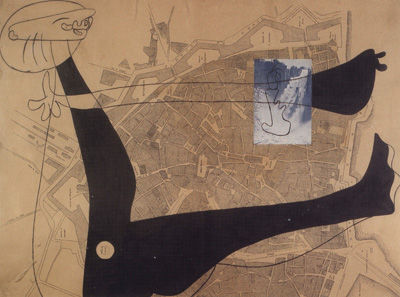DUBUFFET/MIRO/BASQUIAT @ Nassau County Museum of Art (NCMA)
Jean-Michel Basquiat (1984), Third Street, 1984. Acrylic, oilstick, Xerox on canvas, 66 by 60 inches. Batsheva & Ronald Ostrow
ROSLYN HARBOR, NY.- Nassau County Museum of Art (NCMA) will present works by Joan Miró, Jean Dubuffet and Jean-Michel Basquiat, shown together for the first time. The artists do not share generation nor culture, but they do share a confrontational antagonism to the traditional and academic, resulting in art that is raw, bold and forthright. Primal symbols characterize their work in personalized types of graffiti that exist in a timeless, unidentifiable space. In the work of these artists, signs and color erupt in a free association of structure and rhythm; the mysterious act of painting is shown as wild and free, yet also very exacting. Miró/Dubuffet/Basquiat opens at NCMA on March 13, 2010 and remains on view through May 24, 2010.
Joan Miró (1893-1983) was born in Barcelona. He studied art at the Barcelona School of Fine Arts and at the Academia Gali. In the beginning of his career he dabbled in different painting styles that were fashionable at the time, among them Fauvism and Cubism. In 1920 Miró made the first of a series of trips to Paris, settling there in 1921. He met Pablo Picasso and many of the other great painters and artists living in the center of arts in the late 19th and early 20th centuries. From 1924 on, Miró joined the circle of the Surrealist theorist, André Breton, increasingly painting in that style. But he never integrated himself completely and remained somewhat of an outsider. By the 1930s, Miró’s fame and recognition had become international. From 1940 to 1948 he was back in Spain and visiting the U.S. where he had several solo exhibitions including a retrospective at MoMA.
Jean Dubuffet (1901-1985) lived in Montparnasse, where, in addition to painting, he read widely in ethnology, paleography, and ancient and modern literature. After seven years, he abandoned painting and became a wine merchant. During the ‘30s, he painted again for a short time, but it was not until 1942 that he began the work that has distinguished him as an outstanding innovator in postwar European painting. His interest in art brut, the art of the insane, and that of the untrained person, whether a caveman or the originator of contemporary graffiti, led him to emulate this directly expressive and untutored style in his own work. His paintings from the early forties in brightly colored oils were soon followed by works in which he employed such unorthodox materials as cement, plaster, tar, and asphalt-scraped, carved and cut and drawn upon with a rudimentary, spontaneous line. Variations of this method of working preoccupied him until 1962 when he wrote and illustrated a book, L'Hourloupe, in which he evolved a new stylistic and ideological concept for his later work, both paintings and plastic sculpture.
Jean-Michel Basquiat (1960-1988) was born in Brooklyn. His father was from Haiti, his mother of Puerto Rican descent. He displayed artistic talent from his earliest years and was encouraged by his mother. In 1977 he began to spray paint cryptic aphorisms on subway trains and around Lower Manhattan and signing them with the name SAMO©. He left home, supporting himself by selling hand-painted postcards and T-shirts. The first public viewing of his art was in 1980, in a group exhibition sponsored by Colab (Collaborative Projects Incorporated). Basquiat continued to exhibit his work around New York City and in Europe, participating in group shows with other emerging contemporary artists. He met Andy Warhol in 1983 and they collaborated on several paintings. Basquiat’s work began to soar in value and was featured in a 1985 New York Times magazine cover story. He continued to experience artistic success until his death of a drug overdose at the age of 27.
Joan Miró (1937), Untitled, ca. 1937. Paper map and oil on canvas. Private collection

/https%3A%2F%2Fprofilepics.canalblog.com%2Fprofilepics%2F1%2F0%2F100183.jpg)
/https%3A%2F%2Fstorage.canalblog.com%2F03%2F02%2F119589%2F96711876_o.jpg)
/https%3A%2F%2Fstorage.canalblog.com%2F11%2F31%2F119589%2F94773502_o.jpg)
/https%3A%2F%2Fstorage.canalblog.com%2F20%2F83%2F119589%2F94772815_o.jpg)
/https%3A%2F%2Fstorage.canalblog.com%2F26%2F72%2F119589%2F75604929_o.jpg)
/https%3A%2F%2Fstorage.canalblog.com%2F59%2F60%2F119589%2F26458628_o.jpg)




/http%3A%2F%2Fstorage.canalblog.com%2F16%2F27%2F119589%2F129331650_o.jpg)
/http%3A%2F%2Fstorage.canalblog.com%2F98%2F10%2F119589%2F120397015_o.jpg)
/http%3A%2F%2Fstorage.canalblog.com%2F54%2F46%2F119589%2F119205652_o.jpg)
/http%3A%2F%2Fstorage.canalblog.com%2F57%2F85%2F119589%2F113093451_o.jpg)